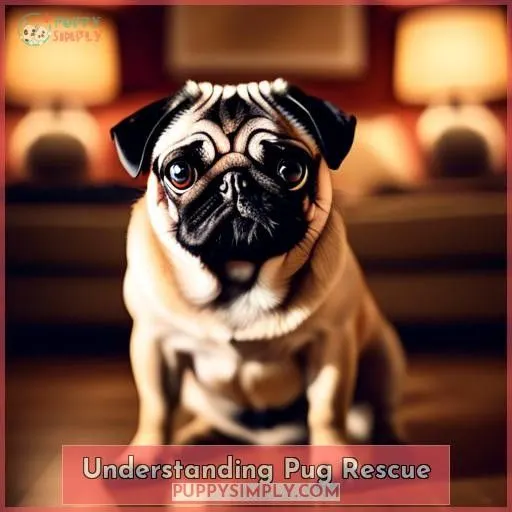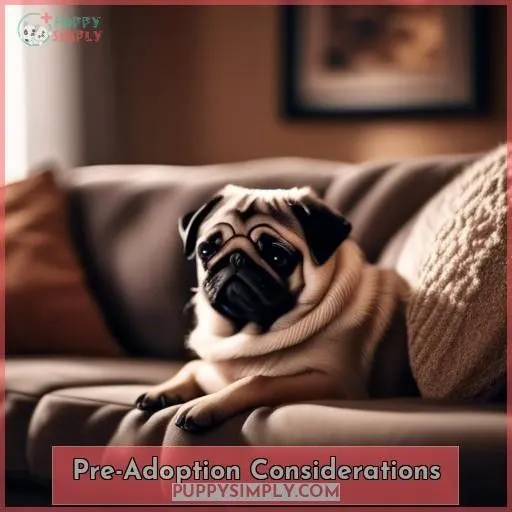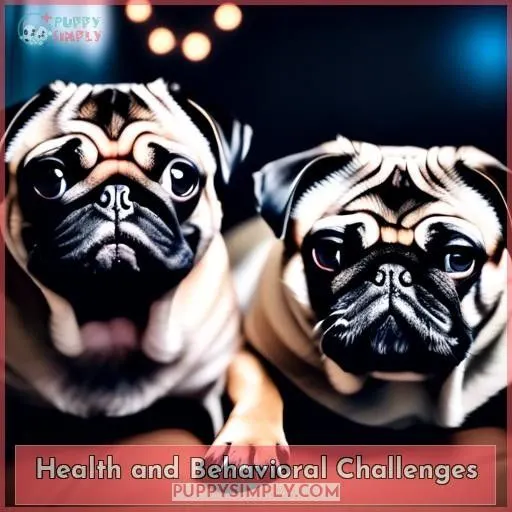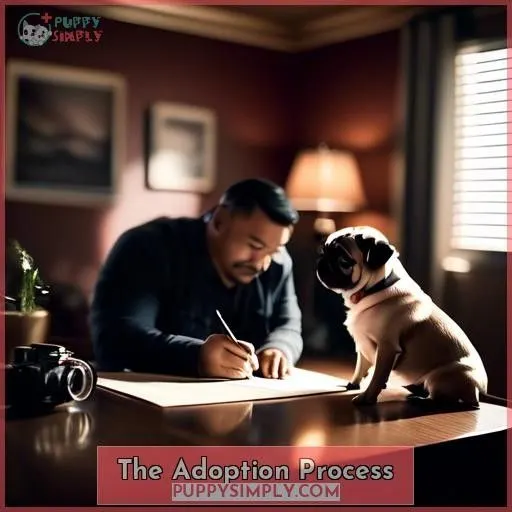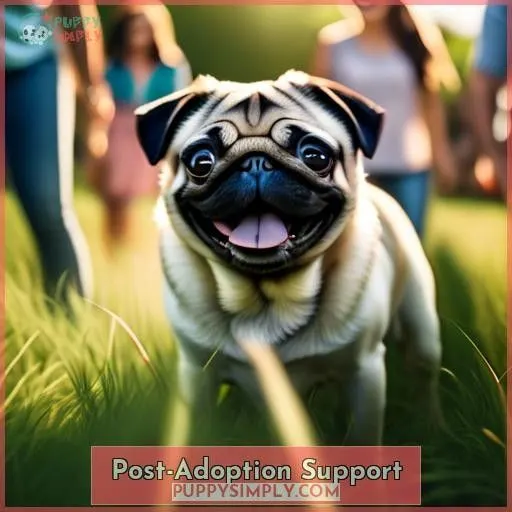This site is supported by our readers. We may earn a commission, at no cost to you, if you purchase through links.
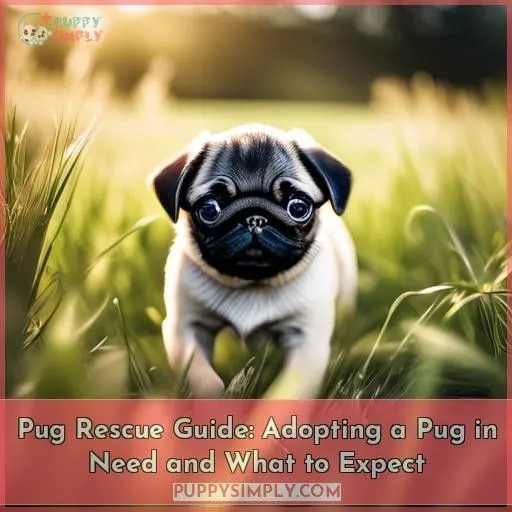
Finding a reputable pug rescue to adopt from is a compassionate way to welcome a furry companion into your home. Rescue pugs come with unique personalities and sometimes health or behavioral challenges, but pug rescue organizations provide invaluable guidance and support throughout the process.
Be prepared for the financial responsibilities of ongoing veterinary care, patience during training, and understanding of any special needs. While it requires extra commitment, rescuing a pug in need is an incredibly rewarding experience that will enrich your life in countless ways.
To learn more about what to expect when adopting a rescue pug, keep reading.
Table Of Contents
Key Takeaways
- Rescue pugs often come from challenging backgrounds and may have behavioral issues or health concerns that require special care and attention.
- Adopting a rescue pug involves financial responsibilities, including potential ongoing medical costs, which can sometimes exceed the initial adoption fees.
- Pug rescue organizations provide invaluable support and resources throughout the adoption process, offering guidance on the unique needs of pugs and helping adopters become part of a community.
- The process of adopting a rescue pug requires patience and commitment, especially when it comes to training, socialization, and addressing any special needs or health issues the pug may have.
Understanding Pug Rescue
When you consider rescuing a pug, you’ll be providing a loving home to a pug in need. From abandoned pups to former show dogs, you can find a variety of pugs through reputable rescue organizations that are dedicated to placing these wonderful companions in forever homes.
Reasons Pugs Need Rescue
When you decide to adopt a rescue pug, you’re not just bringing a new pet into your home; you’re saving a life. Rescue pugs often come from difficult backgrounds, having been abandoned, surrendered, or lost. Some may have behavioral issues or health concerns that require special care. Pug rescue organizations work tirelessly to help these dogs find loving homes, promote responsible pet ownership, and provide support and resources for potential adopters.
Adopting a rescue pug is a rewarding experience, but it’s crucial to be prepared for the challenges that may come with their unique needs. These dogs may require ongoing medical care, training, and patience to help them adjust to their new environment. By understanding the reasons why pugs need rescue and the benefits of adopting one, you can make an informed decision about whether this is the right pet for you.
Benefits of Rescuing a Pug
By adopting a pug from a rescue organization, you’re not just providing a loving home for a furry friend, but also saving a life. Rescuing a pug can bring emotional rewards that surpass the adoption cost.
Pug rescue guides and pug adoption resources safeguard the welfare of the dog, making the adoption process smooth and rewarding. Shelter dog adoption offers a variety of pugs, each with unique personalities, from former show dogs to adults requiring less training.
Joining a supportive community can help you navigate the challenges of pug adoption and provide a sense of belonging.
Importance of Pug Rescue Organizations
Pug rescue organizations play a crucial role in the lives of pugs in need. They help pugs find loving homes, provide support for adopters, and promote responsible pet ownership. As a potential adopter, you can benefit from their breed-specific knowledge and community involvement. Here are three ways pug rescue organizations can enhance your pug adoption experience:
- Adoption support: Pug rescue organizations offer resources and guidance throughout the adoption process, ensuring a smooth change for both the pug and the adopter.
- Community involvement: By joining a pug rescue organization, you become part of a supportive community of pug lovers who share your passion for the breed.
- Breed-specific knowledge: Pug rescue organizations have a wealth of knowledge about pug health and behavior, helping you understand and care for your new family member.
Pre-Adoption Considerations
Before adopting a rescue pug, carefully consider your financial capacity to cover its potential health requirements. Be truthful about your experience in training and energy levels to make sure you can provide the appropriate surroundings for a pug in need.
Financial Responsibilities
As you begin your pug rescue journey, it’s important to think about the ongoing costs related to ongoing treatment, vet expenses, and necessary medications. A 2017/18 Pug Patrol Rescue Australia study revealed that almost half of rescue pugs need ongoing medical care, with long-term vet bills potentially being more than the initial adoption costs.
To prepare, read a pug rescue guide, get a city/municipal license, and make sure your new furry friend has proper identification.
Training and Energy Levels
Before adopting a pug, consider the training methods you’ll use, establish house rules, and be aware of their energy levels. Patience is key when dealing with pug anxiety and socialization. Pug training and exercise are essential for a well-behaved companion. Remember, every dog is unique and may require different training techniques.
Special Needs Awareness
Before you bring home a pug with a past, remember, their suitcase isn’t just filled with toys but may include a few special needs. From quirky behaviors to pug-specific health hiccups, your adoption prep should factor in potential vet expenses and pug medication. Embrace their unique personalities, but be ready for challenges like separation anxiety.
It’s all part of the pug rescue guide to love.
Health and Behavioral Challenges
Adopting a rescue pug comes with unique health and behavioral challenges. You’ll need to be prepared to manage anxiety issues and common physical ailments like joint problems and breathing difficulties, while providing the special care these pups often require.
Anxiety in Rescue Pugs
As a responsible pug owner, you must be prepared for the possibility of your rescue pug experiencing anxiety. Anxiety management involves more than just medication; coping mechanisms, support groups, and a serene environment are also essential.
Anxiety medication may be necessary, with varying doses and durations. Remember that your pug’s well-being is your responsibility, and the Pug Rescue Guide is here to assist you in navigating this journey.
Observe your pug’s body language and seek expert advice when necessary.
Common Physical Ailments
As you embark on the path of adopting a rescue pug, anticipate potential health challenges. Numerous pugs encounter vision impairments due to their prominent eyes. Joint issues may stem from excess weight. Brachycephalic airway syndrome, a prevalent ailment among pugs, can be aggravated by obesity. An astounding 65% of rescue pugs necessitate treatment for these conditions.
Appropriate pug care, encompassing a well-rounded diet and regular veterinary check-ups, is imperative for addressing these health concerns.
Special Care Requirements
As a pug owner, you must be prepared for specialized care requirements. Rescue pugs often have health issues and behavioral challenges that necessitate constant attention. Regular vet visits, medication, and specialized grooming are essential. Pug rescue guides can assist you in navigating these challenges. Remember, patience and understanding are paramount when adopting a shelter dog.
The Adoption Process
When you’re ready to welcome a pug into your home, the adoption process begins. Reach out to reputable pug rescue organizations to find the right pug that fits your lifestyle and needs.
Finding the Right Pug
As you explore the pug rescue realm, you’ll encounter a diverse range of ages and temperaments. Some pugs have graced the show ring, while others might be mature canines with well-defined personalities.
It’s crucial to weigh your age preferences, activity levels, and any special requirements when selecting the ideal pug companion.
Each pug possesses its own idiosyncrasies and needs, shaping your pug rescue journey into a unique and tailored experience.
Preparing Your Home
After finding your perfect pug, it’s time to prep your castle for the new monarch. Establish house rules early—think of it as setting the stage for a smooth reign.
Carve out a quiet space for retreats from the royal duties of being adorable. Block access to the throne room (aka off-limits areas) and guarantee your pug’s proper ID for neighborhood explorations.
Welcome home!
Post-Adoption Support
Continuing your pug rescue journey, be sure to prioritize your new companion’s training and socialization. Joining a supportive pug owner community can also provide invaluable resources and a network of experienced owners to help navigate the unique needs of your rescue pug.
Training and Socialization
To help your new rescue pug adjust successfully and flourish, it’s essential to dedicate time and effort to training and socialization**. This won’t just enhance the connection between you and your canine companion but also guarantee they become well-behaved and confident additions to your family.
First, establish a routine for your pug. This includes regular meal times, playtimes, and training sessions. Consistency is key, as it aids your pug in understanding what’s expected of them. Start with basic obedience training, such as teaching them to sit, stay, and come when called. Positive reinforcement techniques, like rewarding good behavior with treats or praise, are highly effective in training pugs.
Socialization is another essential aspect of training. Introduce your pug to various environments, people, and other animals to help them become well-adjusted and confident. This can be done through group training classes, dog parks, or controlled meet-and-greets with other dogs.
Behavior modification techniques may be necessary to address any undesirable behaviors, such as aggression or anxiety. A professional dog trainer can provide guidance and strategies to help you manage these issues.
Health and Safety Measures
As you’ve learned about training and socialization, it’s equally important to safeguard your new pug’s health and safety. First, consider microchipping your pug. This is a critical safety measure in case your pug becomes lost.
Regular emergency veterinary care is vital, especially for pugs with existing conditions. Avoid dog parks where leashes aren’t required, as these can be challenging environments.
Schedule quarterly vet visits for joint care. Be informed about your pug’s health and consider connecting with pug rescue organizations for assistance and resources.
Joining Supportive Communities
After adopting a rescue pug, it’s essential to join supportive communities to help you navigate the journey. These communities will provide invaluable resources, advice, and companionship, ensuring you’re never alone in your pug-owning adventure.
Connect with other pug owners through community connections, volunteer with pug rescue organizations, or foster a pug in need. Engage in online forums and support groups to share experiences and learn from others.
Attend pug meetups, playdates, and events to build a network of like-minded pug enthusiasts.
Frequently Asked Questions (FAQs)
What are the health risks of pug rescue?
Rescue pugs often face physical challenges like joint problems, eye troubles, and breathing issues. But with the right care and treatment, they can thrive in their new homes. Be prepared for potentially higher vet bills.
How long does it take for a pug to adjust to a new home?
Ah, the joys of a new pug pup! Don’t blink – it’ll feel like an eternity before they’re comfy. Buckle up, though – that snuggly sweetheart’s got some serious settling-in to do. Patience, my friend, is the name of this game.
What is the average lifespan of a rescue pug?
Well, rescue pugs have a comparable lifespan to well-bred pugs, around 12-15 years on average. But don’t let their cute faces fool ya – they often need extra TLC and veterinary care. Gotta be ready for the long haul!
Can I adopt a pug with behavioral issues?
Sure, you can adopt a pug with behavioral issues, but it takes patience and commitment. These pups need extra TLC and training, but the rewards of rescuing are paw-some. Are you up for the challenge?
How can I help a pug rescue organization?
Well, your search ends here! Joining paws-itive pug rescue organizations is a mutually beneficial endeavor – you can contribute your support and cuddle some adorable furry companions. Prepare to work hard, it’s time to make a pug-rific impact!
Conclusion
While taking in a rescue pug may appear formidable, it’s an immensely fulfilling experience. With adequate readiness and assistance from pug rescue organizations, you can grant a loving home to a pug in need.
Bear in mind, pug rescues possess idiosyncratic personalities and occasionally health challenges, but the delight they bestow far eclipses the additional dedication necessitated.
By adopting a pug rescue, you’ll not merely preserve a life, but also augment your own in innumerable ways.

